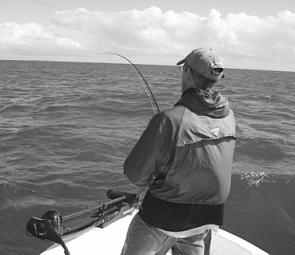Pelagic fish are an excellent target in Moreton Bay in April.
Longtail tuna, mack tuna, spotty mackerel and school mackerel can be caught from as far south as Macleay Island, right up into the northern end of the bay. The greatest concentrations of fish will be found near bait. Bait is influenced by a number of factors such as food, rainfall, tide, structure and wind.
Tuna and mackerel generally chase small (under 60mm) baitfish in Moreton Bay and feed on tiny plankton sized organisms. Plankton comprises of small plants (phytoplankton) and animals (zooplankton) including algae, various microscopic animals and jellyfish as well as the eggs and larvae of many fish, crustaceans and worms.
Some forms of plankton can move independently up or down in the water column throughout the day, but they are at the mercy of wind and tide for their horizontal movements. Current lines trap plankton in their swirling eddies. A current line can be identified by a colour change on the water and by patches or long ribbons of dirty planktonic matter floating on the surface. These attract the baitfish, which in turn attract larger predators, so they are always worth investigating when on a tuna or mackerel hunt.
When the wind blows consistently from one direction for a few days, the plankton and baitfish will be pushed along with the breeze, pushing food along whatever shoreline they are blown towards. For example, when a southeasterly has blown for a few days the areas from Cleveland Point through to Wellington Point and up to Mud Island will have more bait than they would have had after a week of westerlies.
Winds also push currents against the coast, and southeasterlies bring warmer, clean water into the bay and push bait schools up along the beaches. When bait schools come into the bay there are often big feeding frenzies of pelagics around the seaward end of the Rous and Rainbow channels, Jumpinpin and the top of Cape Moreton.
Rainfall further up the catchment flushes both baitfish and their planktonic food supply from the rivers. After heavy rains there is often a distinct dirty water line at the mouth of the Brisbane River and between Coochiemudlo and Macleay islands (sometimes extending right up to Peel Island). When this happens it’s the obvious place to start looking for tuna, mackerel and tailor.
Structure is always a good place to look for pelagic fish; it can be anything from a marker beacon to a sandbank to a whole island. Structure can be a food resource, an interruption from strong currents and provide cover from predators. The coral edges of islands such as Mud, St Helena and Peel are an obvious place for bait to seek shelter from strong currents and to pick up food coming from the reef and off the current lines. Deeper reefs in the middle of Moreton Bay produce upwellings of current that hold bait.
Another less obvious place to look is along the edges of sandbanks on a falling tide. Bait that hides in weedbeds and gutters on the top of the tide becomes vulnerable as the tide recedes so it’s forced into the deeper water. Similarly, large bait schools in open water become easy prey when they are herded up against a sandbank by a pack of tuna or mackerel.
This is just a short overview of some of the factors that effect the movement of bait and pelagics around Moreton Bay. The same kind of thinking can be used to identify areas of reef fish activity too as they also follow concentrations of food from reef to reef.
Until next month, tight lines, or for more information on the southern Moreton Bay area, come and see me at Fish Head (Cnr Broadwater Tce and Stradbroke St, Redland Bay, www.fishhead.com.au) or call us on (07) 3206 7999.
Reads: 3248
Paul Wright tight to a longtail in rough conditions.

A longtail from the Rainbow Channel.




